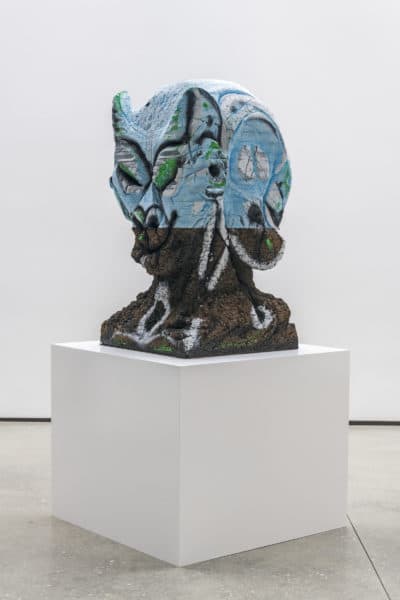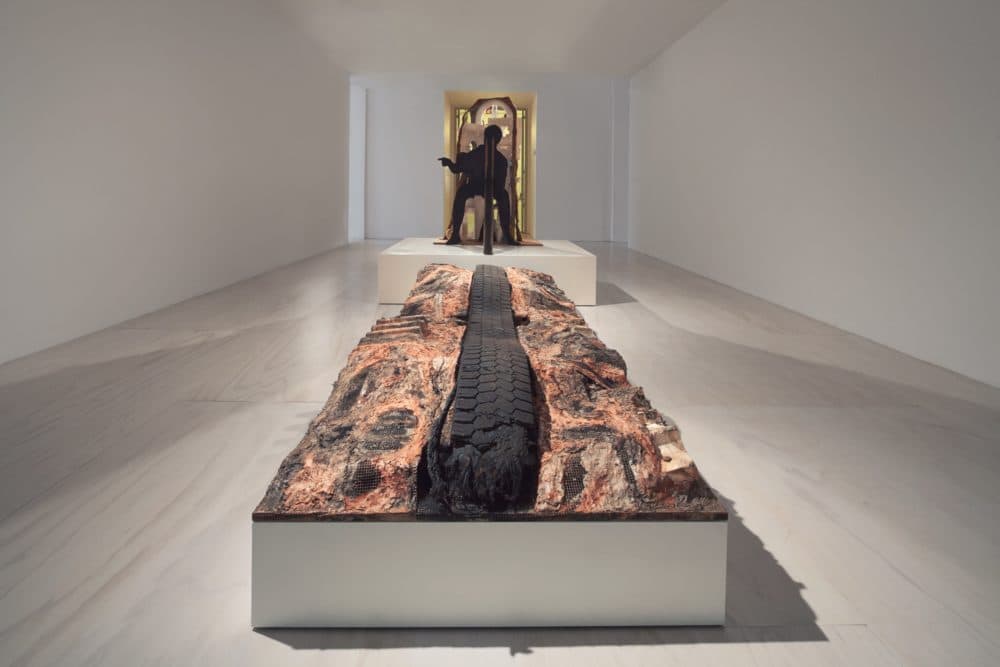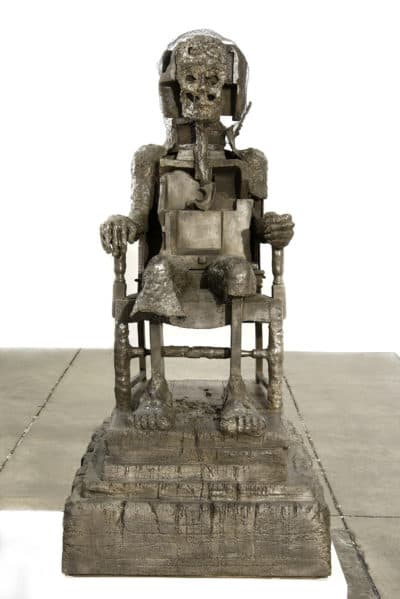Advertisement
In 'They Live,' Huma Bhabha Channels A Tragi-Comic View Of The Grotesque

Wandering among Huma Bhabha’s sculptures you might think, for a second, you’d been dropped among the monumental statues of Easter Island. But unlike the present-day Polynesian isle, it’s neither green nor tranquil. These figures seem to reflect a post-apocalyptic world of urban decay, a world of aliens and monsters, comic books and high art, a land where maybe the natives have watched a few too many horror movies.
Larger-than-life figures carved out of cork and Styrofoam are marked with acrylic paint. They are reminiscent of totems, Egyptian sarcophagi or perhaps Greek korai, made in an ancient time but defaced yesterday by those pesky neighborhood kids. Bronze figures look like they’ve been dropped from the hold of a spaceship. Large heads of clay, wire and wood, sometimes charred, scream like mummified figures at Pompei. Leering zombie masks seem to have come straight out of the wardrobe department of a David Cronenberg film.
In fact, the figures in Bhabha’s “They Live,” a survey of 20 years’ worth of the artist’s work on view beginning Saturday at the Institute of Contemporary Art, seem to be an amalgamation of all things and all times, one big heap of humankind (or alienkind) in all its pathos and glory. If there is such a thing as the collective unconscious, reflecting ancestral memory and human experiences of both horror and humor, this would be the embodiment of it. The ideas within Bhabha’s work are big ones — not because she’s overly philosophical, she says, but "because they deal with good and evil, death, the effects of war and violence, and the landscape where all of this transpires."
In other words, Bhabha’s work lives squarely in the land of gods and demons, fear and worship, archetypal symbols of myth and religion that speak to universal desires and basic human needs.

On view are not just what Bhabha refers to as “assemblages,” or sculptures combining a host of materials both found and made, but also drawings, photography and two-dimensional mixed media work. Each piece seems to reference a confounding number of artistic practices, cultures, historical eras, mediums and experiences into a look that is uniquely Bhabha’s. Aside from Egyptian, Indian and classical Greek statuary, there are references to tribal art and African masks. There are allusions to the urban detritus Bhabha saw as a child growing up in her native Pakistan, but that is scattered about any large, urban center, whether it be Karachi or New York. Drawing from the well-stocked shelves of art history, we can see hints of German Expressionism, art brut, the graffiti-like scrawls of Cy Twombly and Jean-Michel Basquiat, shades of Alberto Giacometti’s lean sculptures and even Willem de Kooning’s smeared faces. The whole of art history seems to be threaded through what Bhabha refers to as her “characters.”
Advertisement
And in all that history, there is, Bhabha admits, some darkness.
“I do feel we have been living in apocalyptic times,” she says. “I am aware of the dark side. These ideas that are now mainstream I have been thinking of the last 25 years.”
Although much of the exhibit is dedicated to Bhabha’s three-dimensional work, you’ll notice that her sculptures often incorporate painting. There’s a reason for that. Bhabha attended the Rhode Island School of Design where she obtained a degree in painting and printmaking before getting an MFA at Columbia University. She has thus never been formally trained in sculpture, which has given her a license to play in unconventional ways.
And thus, we have “Four Nights of a Dreamer” (2018), in which Bhabha has created a large four-sided bust of cork and Styrofoam, set on a lacquered wood pedestal. Each side of the bust is incised but also painted. On one side is a canine-like demon, on another, there is a face recalling Edvard Munch’s “The Scream.” Are these nightmares from an ancient past? Fears of a "Mad Max" future? Or, perhaps, simply angst borne of our dubious present?

In “The Orientalist” (2007), a bronze figure sits on what seems to be a throne. Recalling the seated figures in ancient Egyptian art, this figure appears to be half human, half machine. The title of the piece refers to Edward Said’s 1978 book “Orientalism,” which critiqued the West’s arrogance and prejudice against Middle Eastern, Arab and Islamic societies. The viewer is allowed to draw her own conclusions about what Bhabha may be saying regarding the impact of colonialism and imperialism in the Middle East.
Another work on view, “Benaam” (2018), belongs to a group of related works that Eva Respini, curator of the exhibit, says she first saw at MoMA’s Greater New York Show of 2005. It features a prostrate figure in a deep bow. The work is bronze but has been painted and patinated to look like a figure draped in a plastic garbage bag with only hands visible. The original version of this statue was shown during the Iraq War in a period in which photographs of soldiers in body bags appeared regularly in newspapers. The work perfectly encapsulated the times, says Respini, and “that’s when I took note.”
She kept an eye on Bhabha, appreciating her work for its “wide range of associations” in art, history, culture, philosophy. Respini says she was especially captivated by Bhabha’s own fascination with materiality. One work might combine all sorts of new and old materials, including the combination for which she is best known — post-industrial Styrofoam and age-old organic cork. While glorying in a treasure trove of materials, Bhabha’s work almost always gives primacy to the figure and is created mostly by Bhabha’s own hand in a converted firehouse in Poughkeepsie, New York.
The idea of creating assemblages of odd materials came naturally to Bhabha, given her own memories of Pakistan. In Karachi, “garbage pickers” traveled house to house to pick up household cast-offs that could later be sold to be recycled. Her studio practice of assembling discards today is a continuation of all that.
“I find beauty in rawness, but I’m a happy person,” she says. “There’s a lot of humor in the work that is subtle.”
The unlikely combination of materials, she says, is “why my work has a different kind of presence, because it’s made in a different way.”
“I’ve always been interested in trying to make something that looks original,” she says. “I have a certain aesthetic I really like … I’m interested in a certain kind of raw landscape because I grew up in that and I feel completely comfortable in that.”
Film and television play a big role in Bhabha’s work, particularly sci-fi and horror films. The title of the exhibit, in fact, references a 1988 John Carpenter film by the same name, in which a wanderer discovers a pair of sunglasses that allow him to see the world as it really is — a world in which skull-faced aliens bent on world domination insert subliminal messages into the media and advertising to keep the population subdued.
It may be hokey and funny, or, we intimate from Bhabha’s work, it may be our reality.
“They Live” is on view at the ICA in Boston through May 27.
